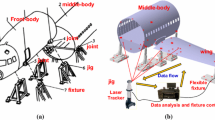Abstract
This paper presents an improved methodology for evaluating the position and orientation errors of airfoil sections of a manufactured aero-engine blade. The existing method estimates these errors by finding rigid-body transformations with translational and rotational parameters altogether to best match the inspection data points onto the design airfoil profiles. Such transformations lead to unreliable evaluation results due to combining the position and orientation errors with each other. This paper proposes to decouple the position and orientation errors in their evaluation in order to avoid the combining effect. To isolate the position error from the orientation error, an important location tolerance evaluation feature, the centroid of a manufactured airfoil section, must be correctly identified from the sectional inspection data points. Identifying the centroid location directly from discrete data points is subject to an error caused by biased area calculations on the pressure and suction sides of an airfoil. This work proposes to reconstruct a valid airfoil profile from the inspection data points for each airfoil section to overcome the area bias problem and to maintain consistency in identifying the centroid. With the centroid of each inspected airfoil section identified, the position error and the orientation error can then be evaluated in sequence. A series of case studies has been performed to demonstrate the effectiveness of the proposed methodology and how it is able to prevent wrongful rejection/acceptance of geometrically acceptable/unacceptable blades as well as incorrect modification of the related manufacturing processes.
Similar content being viewed by others
References
Makem JE, Ou H, Armstrong CG (2012) A virtual inspection framework for precision manufacturing of aerofoil components. Comput Aided Des 44:858–874
Wang MH, Sun Y (2014) Error prediction and compensation based on interference-free tool paths in blade milling. Int J Adv Manuf Technol 71:1309–1318
Cardew-Hall M, Cosmas J, Ristic M (1988) Automated proof inspection of turbine blades. Int J Adv Manuf Technol 3:67–88
Jinkerson RA, Abrams SL, Bardis L, Chryssostomidis C, Clément A, Patrikalakis NM, Wolter FE (1993) Inspection and feature extraction of marine propellers. J Ship Production 9:88–106
Pahk HJ, Ahn WJ (1996) Precision inspection system for aircraft parts having very thin features based on CAD/CAI integration. Int J Adv Manuf Technol 12:442–449
Hsu TH, Lai JY, Ueng WD (2006) On the development of airfoil section inspection and analysis technique. Int J Adv Manuf Technol 30:129–140
Besl PJ, McKay ND (1992) A method for registration of 3-D shapes. IEEE Trans Pattern Anal Mach Intell 14:239–256
Khameneifar F, Feng HY (2014) Airfoil profile reconstruction under the uncertainty of inspection data points. Int J Adv Manuf Technol 71:675–683
Lee SY, Kim KY (2000) Design optimization of axial flow compressor blades with three-dimensional Navier-Stokes solver. KSME Int J 14:1005–1012
Abbott IH, von Doenhoff AE (1959) Theory of wing sections: including a summary of airfoil data. Dover Publications, Mineola, New York
Davis PJ, Rabinowitz P (1984) Methods of numerical integration, 2nd edn. Academic, New York
Li Y, Gu P (2004) Free-form surface inspection techniques state of the art review. Comput Aided Des 36:1395–1417
Zhu L, Barhak J, Srivatsan V, Katz R (2007) Efficient registration for precision inspection of free-form surfaces. Int J Adv Manuf Technol 32:505–515
OuYang D, Feng HY, Jahangir NA, Song H (2012) Robust initial matching of free-form objects represented by point clouds. J Manuf Sci Eng 134:021008
Piegl LA, Tiller W (1997) The NURBS book. Springer, New York
Rao SS (2009) Engineering optimization: theory and practice. Wiley, New Jersey
Savio E, De Chiffre L (2002) An artefact for traceable freeform measurements on coordinate measuring machines. Precis Eng 26:58–68
Author information
Authors and Affiliations
Corresponding author
Rights and permissions
About this article
Cite this article
Khameneifar, F., Feng, HY. A new methodology for evaluating position and orientation errors of airfoil sections. Int J Adv Manuf Technol 83, 1013–1023 (2016). https://doi.org/10.1007/s00170-015-7641-x
Received:
Accepted:
Published:
Issue Date:
DOI: https://doi.org/10.1007/s00170-015-7641-x




